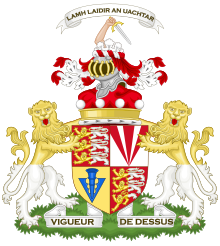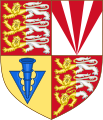File:Arms of O'Brien, Baron Inchiquin.svg

Original file (SVG file, nominally 410 × 478 pixels, file size: 1.34 MB)
Captions
Captions
Summary
[edit]| DescriptionArms of O'Brien, Baron Inchiquin.svg |
English:  Quartered arms of w:Murrough O'Brien, 1st Earl of Thomond, 1st Baron Inchiquin. Quarterly of 4:
 The O'Brien (Ó Briain) dynasty, kings of Munster, Ireland, was founded in the 10th century by w:Brian Boru who by conquest became High King of Ireland. Brian's descendants thus carried the name Ó Briain, continuing to rule the Kingdom of Munster until the 12th century when their territory had shrunk to the Principality of Thomond. The last Ó Briain to reign in Thomond was Murrough Ó Briain (d.1551) who surrendered his sovereignty to the new Kingdom of Ireland under the rule of King Henry VIII of England, being created instead (1543) w:Earl of Thomond and maintaining a role in governance. To show this resignation of the Gaelic Order and showing loyalty to the new king and government, the old heraldic arms (A dexter forearm grasping a sword in pale proper) (per The Chief Herald of Ireland’s office) were discarded (but retained as a crest) and King Henry VIII granted to Murrough his own personal arms of Plantagenet, differenced by tincture of the lions (party per pale or and argent) and by the absence of armed and langued azure (O'Brien, Donough, History of the O'Briens from Brian Boroimhe, AD. 1000 to AD. 1945, London, 1949, pp.50-54 & 198). "From an English point of view this was a great honor, but to the Ui Briain Clan, the Irish, and the Gaelic Order, it was surrender and defeat" (Garry Bryant / Garaidh Ó Briain, O'Brien Clan Heraldry, History of O’Brien Clan Heraldry, (Irish Armiger, 1992) [2]) Quarterings: The quarters are (2nd): Argent, three piles in point issuing from the chief gules and (3rd): Or, a pheon point down azure, both also adopted in 1543. Ivar O’Brien (1992) believes the three piles to be an earlier symbol of O’Brien of Arra in County Tipparary (a branch of the O’Brien Clan and described as being "a law unto themselves"). However strong circumstantial evidence suggests that they were a difference of the arms of the entirely unrelated Sir w:Francis Bryan (1490-1550) a courtier of King Henry VIII and Lord Justice of Ireland during the reign of his son King Edward VI, adopted to show loyalty to the English crown. Sir Francis Bryan was of the Anglo-Norman de Bryan family, from Devonshire in England and Pembrokeshire in Wales, founded by Guy de Bryan. The pheon was adopted to show loyalty to Sir w:Henry Sidney, w:Lord Deputy of Ireland, (1565–71 & 1575–78) whose family arms were identical: Or, a pheon point down azure (Ivar O’Brien, The O’Brien Arms: a Speculation of their Origin, The Royal O’Briens: a Tribute, 1992, p.61). See also: Garry Bryant / Garaidh Ó Briain, O'Brien Clan Heraldry, History of O’Brien Clan Heraldry, (Irish Armiger, 1992) [3]. See also: O’Brien Knot, a heraldic badge of the family, seen for example on a corbel next to the fireplace at Lemenah Castle in north-west County Clare. |
| Date | |
| Source | Own work |
| Author | MostEpic |
Licensing
[edit]- You are free:
- to share – to copy, distribute and transmit the work
- to remix – to adapt the work
- Under the following conditions:
- attribution – You must give appropriate credit, provide a link to the license, and indicate if changes were made. You may do so in any reasonable manner, but not in any way that suggests the licensor endorses you or your use.
- share alike – If you remix, transform, or build upon the material, you must distribute your contributions under the same or compatible license as the original.
File history
Click on a date/time to view the file as it appeared at that time.
| Date/Time | Thumbnail | Dimensions | User | Comment | |
|---|---|---|---|---|---|
| current | 16:46, 12 August 2023 |  | 410 × 478 (1.34 MB) | MostEpic (talk | contribs) | minor changes |
| 17:46, 3 February 2023 |  | 430 × 500 (372 KB) | MostEpic (talk | contribs) | Uploaded own work with UploadWizard |
You cannot overwrite this file.
File usage on Commons
The following 2 pages use this file:
File usage on other wikis
The following other wikis use this file:
- Usage on en.wikipedia.org
- Usage on it.wikipedia.org
Metadata
This file contains additional information such as Exif metadata which may have been added by the digital camera, scanner, or software program used to create or digitize it. If the file has been modified from its original state, some details such as the timestamp may not fully reflect those of the original file. The timestamp is only as accurate as the clock in the camera, and it may be completely wrong.
| Width | 409.64868 |
|---|---|
| Height | 478.31949 |